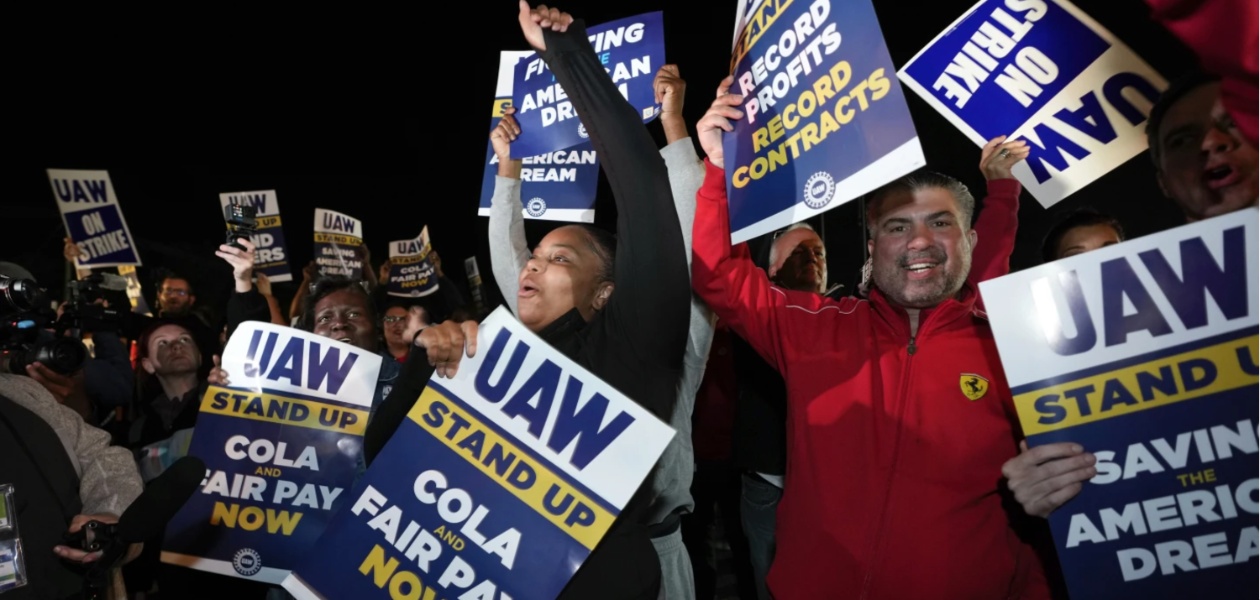
DETROIT—The United Auto Workers started their strike against Detroit’s Big 3 car companies—Ford, GM, and Stellantis/FiatChrysler—when their contracts expired at a minute before midnight on September 14.
In the union’s new “Stand Up” strike strategy, the UAW opened the strike with up to 13,000 members of three locals, one per company, taking to the picket lines: GM Local 2250 in the St. Louis suburb of Wentzville, Mo., Stellantis Local 12 in Toledo, Ohio, and Local 900 at the Ford Final Assembly and Paint Plant in Wayne County, Mich.
In an address to the nation today, President Biden put his thumb on the scale in favor of the workers. “Record auto company profits which they have,” he said, “must mean record contract gains for the workers. When workers earn more, it helps the entire economy across the board.” The president said that the Big Three auto companies “have not given the workers a fair share of the profits they have been making.”
If the companies don’t take the workers seriously, more and more locals plan to walk in ensuing days, at a moment’s notice, union President Shawn Fain said.
“The world is watching. The UAW is ready to stand up,” Fain declared in a brief video message at 10 p.m. Eastern Time, two hours before the deadline.
Before then, there was round-the-clock bargaining during the final day involving the union and negotiators from all three firms meeting at UAW’s Solidarity House. Fain did not discuss in the late-night video how close or how far apart the union and the Detroit car companies still were. The companies, the nation, and the world got their answer at Midnight as the workers, under cover of night, began their historic walkout.
Fain alerted members of other locals to be ready to join the three at a moment’s notice.
UAW is using that strategy, which Fain previously announced in an evening video, to keep the three car companies off balance and guessing which plants will shut down and when. Answering texts in the video’s chat box, Fain noted hundreds of people wanted a complete strike against all three car companies everywhere when the contracts ran out. Fain said that’s still an option if the companies drag their feet on the reasonable demands of the workers.
UAW’s bargainers as a group decided on this “Stand Up” local-by-local strategy instead. The uncertainty of who will be summoned to picket lines next will keep the pressure on, Fain explained to his members.
Meantime, all other Auto Workers will toil under the old expired contracts, without an extension. But Fain assured them they’re safe under labor law. “You are not an employee at will,” he said. The union’s website explains how they’re safe, he said. The firms employ a total of 150,000 Auto Workers.
“The companies, our members and the public know what we’re fighting for. No matter what we do we need to keep organizing. We need to show the companies we are ready to stand up.”
Besides dollars, the strike is a class struggle, Fain declared.
“I want us to stand up against corporate greed,” he declared in that video. “It’s the working class versus the billionaire class.”
“This is a stand-up strike against massive inequality,” just like the historic and successful sit-down strikes of the 1930s, he added.
Demands they come to their senses
The union demands the three firms, flush with profits—a quarter of a trillion dollars combined over the last several years and another $21.5 billion combined in the first six months of this year–come to their senses and agree on new contracts covering the 150,000 Auto Workers they employ.
The pacts would make up for 15 years of wage stagnation, two-tier pay systems, and cuts in health and pension benefits.
“This is our generation’s defining moment,” Fain added. Both videos aired on Facebook. “The cause is just. The whole world is watching.”
Dollars—a fair share of them–are the top issue and the two sides are still far apart. But as one young UAW Local 600 worker said later, workers suffer from conditions inside plants, too.
Those conditions include 12-hour days of excruciating repetitive-motion work, mandatory overtime, breaks so short—10, 10, and 20 minutes—there’s barely enough time to run to the bathroom, and mandatory work every third Sunday, too. A worker at the Ford final assembly plant in Wayne County, Michigan said she had 55 seconds to do two checks and install four key parts, over and over and over and over again.
And that worker, on the second of two tiers, started at $16.25 an hour and cannot attain top scale for eight years. The Big 3, Fain said, proposed cutting that progression to four years. The workers and their union want to eliminate the two-tier system altogether.
The issues workers face go far beyond just what happens on the job. They are faced with the fact that workers, not just the wealthy in this country, are entitled to relaxation time and quality time with families, away from the job. They need to spend time not just with immediate families and children facing the problems of growing up but with the aging parents they love so dearly. None of this is too much for any human being to ask, they say. Companies, with their forced overtime and back-breaking 12-hour shifts are concerned, they say, with none of this. They appreciate the fact that they have, in Shawn Fain, a union leader who understands this and correctly frames their battle with the Big 3 as part of a broader class struggle.
To make up for the past losses, the UAW wants across-the-board raises of at least 36% over four years, restoration of cost-of-living increases—forced out when the Obama administration assembled a rescue package for then-bankrupt GM and FiatChrysler–pension increases for retirees who haven’t had a raise in a decade, and improved health care, among other goals. New hires are virtually left on their own for pensions and health care.
The companies offered raises of 17.5% (Stellantis), 18% (GM) and 20% (Ford) over four and a half years, plus one-time signing bonuses. Profit-sharing would actually shrink 21% under Ford’s proposal and 29% under GM’s, Fain said in the prior video. Stellantis hadn’t presented a proposal yet.
The firms didn’t budge on ending mandatory overtime or restoring COLAs. Their top economic concession added Juneteenth as a holiday. Nobody mentioned the long shifts and the companies tuned out UAW’s demand for gaining workers family time via 32-hour weeks at 40 hours’ pay.
Speaking to National Public Radio while on the Michigan picket line later, Fain said the car companies didn’t take the union seriously until the very final days of the talks.
Yet the mainstream media parrots car company bosses’ talking points that they offered UAW the best contracts ever. Or it twists the story by calling the UAW greedy or, on NBC, predicting a strike would cause car prices to rise, finding one dealer to say so, without investigating further to see if it’s true. It’s not.
Trust your union
Fain’s reply: “Trust your union” to tell the truth about workers’ demands and company replies.
One Ford worker and sometime local union leader added the mood on the shop floor is that workers are both ready and militant.

In the last 10-15 minutes of the prior video, Fain scrolled through comments streaming in to session’s chatbox. Hundreds of the writers favored striking all three car companies at all of their plants, all at the same time, if there were no new, acceptable contracts by the deadline, 11:59 pm, Eastern Time, on September 14.
Fain appreciated the commenters’ demands, but explained the union’s entire bargaining committee, which has participated in all the sessions with the Detroit 3, agreed the “Stand up for workers! Stand up for America!” strategy was the best route to go.
“I see people want to go out at once,” Fain said. “That’s still an option…We may strike all of the Big 3 at once. But if you’re not called” to strike “continue to work until you are.”
The point, he said, is to keep the car companies off balance, wondering which plants UAW will call the strike at next. Fain told locals not on the initial strike list to stay ready, and meanwhile participate in rallies, picketing where they can, and other pro-worker acts. He also announced a mass rally at 5 p.m. on September 15 in downtown Detroit, with no bargaining occurring that day.
“This is a decision by a lot of people, who are on your teams, trying to figure out the best way to strategize” to make new and generous contracts occur, he said.
The new strategy is one of a number of innovations Fain and his reform team instituted at UAW since they were directly elected by the membership to the leadership of the influential union five months ago. Another is mass meetings, at plants and via video, to constantly inform and engage members on issues forcing them to strike.
Fain also has given nightly video reports on negotiations’ progress or lack of it, a change from prior UAW leaders’ actions. He drew 29, 000 views for the September 13 preparation video. Former UAW leaders kept bargaining behind closed doors and contracts under wraps until after their completion.
Fain had one other point: The car companies plowed their profits over the last contract into stock buybacks for Wall Street investors and multi-million-dollar annual pay and perks for corporate honchos, not workers’ paychecks. Union members deserve their fair share of the money they make for the car companies.
That’s not just his opinion, Fain declared. In shows of solidarity, it’s the members’ opinion.
>>> READ MORE PEOPLE’S WORLD COVERAGE OF THE UAW STRIKE.
We hope you appreciated this article. At People’s World, we believe news and information should be free and accessible to all, but we need your help. Our journalism is free of corporate influence and paywalls because we are totally reader-supported. Only you, our readers and supporters, make this possible. If you enjoy reading People’s World and the stories we bring you, please support our work by donating or becoming a monthly sustainer today. Thank you!













Comments